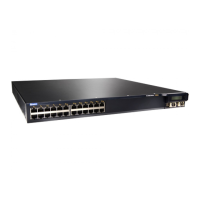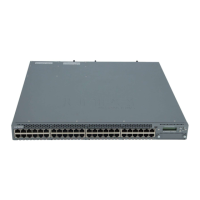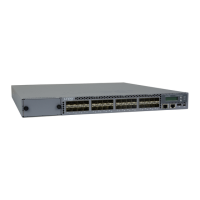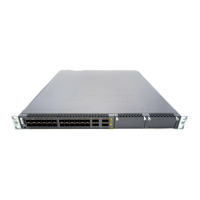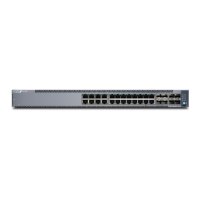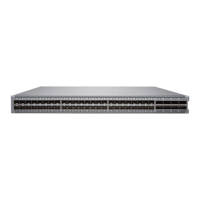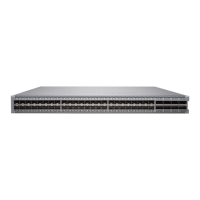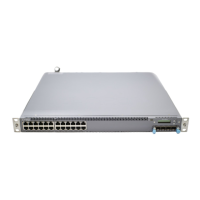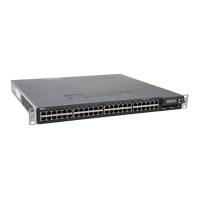
Do you have a question about the Juniper EX4200 and is the answer not in the manual?
| Model | EX4200 |
|---|---|
| Switching Capacity | 128 Gbps |
| Layer | Layer 2 and Layer 3 |
| Form Factor | 1U |
| Throughput | 96 Mpps |
| Maximum VLANs | 4096 |
| MAC Address Table Size | 16, 000 |
| DRAM | 1 GB |
| Flash Memory | 1 GB |
| Forwarding Rate | 96 Mpps |
| JUNOS Software | Yes |
| Ports | 24 or 48 |
| Stacking | Up to 10 switches in a Virtual Chassis configuration |
| Power Supply | AC or DC |
| Management | CLI, SNMP, J-Web |
| Input Voltage | 100-240 VAC or -48 VDC |
| Operating Temperature | 0°C to 45°C |
| Redundancy | Redundant power supplies |
| Virtual Chassis Technology | Yes |
| Storage Temperature | -40°C to 70°C |
| Humidity | 5% to 90% non-condensing |
Overview of the Juniper Networks EX Series Ethernet Switches, including their role and features.
Details on EX4200 switches for medium- and high-density environments and scalability.
Information on available EX4200 switch models, including port count and PoE capability.
Description of hardware terms and corresponding Junos OS CLI terms for EX4200 switches.
Summary of the physical specifications for the EX4200 switch chassis.
Identification of components that can be replaced on-site in EX4200 switches.
Description of components and LEDs found on the front panel of an EX4200 switch.
Description of components located on the rear panel of an EX4200 switch.
Details about the LCD panel on the front of the switch and its navigation buttons.
Description of the four types of uplink modules supported by EX4200 switches.
Information on the three LEDs on the far right of the front panel next to the LCD panel.
Description of the two LEDs on the management port indicating link/activity and port status.
Explanation of the LEDs on network ports, including status indicators for port parameters.
Description of the cooling system, consisting of a field-replaceable unit (FRU) fan tray.
Details about the location and function of the fan tray in the rear of the chassis.
Explanation of how the fan tray provides side-to-rear chassis cooling.
Information on installing and replacing the hot-removable power supply unit (FRU).
Details on available AC power supply models (320 W, 600 W, 930 W) and their features.
Information on the DC power supply, its dual input feeds, and lack of PoE support.
Explanation of how PoE power budget is determined by power supply capacity.
Description of the LEDs on the AC power supplies indicating power status.
Description of the LEDs on the DC power supplies and their states.
Using the J-Web interface dashboard to view system information.
Displays a graphical view of the switch chassis and each member switch in a Virtual Chassis.
Provides details on system name, device model, inventory, Junos OS, and boot image versions.
Displays memory utilization, flash usage, temperature, CPU load, and fan status.
Shows the number of active ports, total ports, MAC-table entries, and VLANs configured.
Displays information about the last five alarms raised in the system.
Checklist of tasks for preparing a site for EX4200 switch installation.
Guidelines for installation environment: altitude, humidity, temperature, and seismic.
Guidelines for efficient device operation, site planning, maintenance, and layout.
Factors to consider when planning electrical wiring at the site.
Specifications for mounting the switch on two-post or four-post racks.
Requirements for mounting the switch in a cabinet that contains a 19-in. rack.
Instructions for installing the switch on a desktop or wall, including clearance.
Guidelines for sufficient clearance around the installed switch for airflow and maintenance.
Description of power supply specifications for EX4200 switches.
Details on the detachable AC power cord, its coupler type, and plug standards.
Method for calculating link power budget for fiber-optic connections.
Method for calculating the link power margin considering attenuation and link loss.
Description of SFP, SFP+, and XFP transceivers supported by uplink modules.
Information on small form-factor pluggable plus transceiver (SFP+) direct attach copper cables.
Details on network interfaces and cable types used with EX4200 switches.
Understanding how signal loss, attenuation, and dispersion affect fiber-optic transmission.
Pinout information for the RJ-45 console connector.
Information on USB flash drives tested and supported for EX Series switches.
Pinout information for the RJ-45 management port connector.
Pinout information for the RJ-45 network port connector.
Pinout information for the RJ-45 to DB-9 serial port adapter.
Pinout information for the uplink modules connector on the front panel.
Pinout information for the 68-pin connector cable used for Virtual Chassis ports.
How to interconnect EX4200, EX4500, and EX4550 switches into Virtual Chassis.
Ports available for connecting Virtual Chassis members.
Dependence of switch roles and count on Junos OS release.
Availability of Virtual Chassis modules for EX4500 and EX4550 switches.
Display of switch role (RE, BK, LC) and member ID on the LCD panel.
Procedure for unpacking the EX4200 switch chassis from its shipping carton.
Details of parts included in the switch shipment and quantities.
Importance of registering products for activating hardware service-level agreements (SLAs).
Steps to install and connect an EX4200 switch, including power supply and fan tray installation.
Methods for mounting the EX4200 switch on two-post racks, four-post racks, or a wall.
Instructions for mounting the switch on a desk or level surface using rubber feet.
Procedure for mounting the switch on two posts in a 19-in. rack or cabinet.
Procedure for mounting the switch on four posts in a 19-in. rack or cabinet.
Instructions for mounting the switch recessed 2 inches from the rack front.
Instructions for mounting the switch on a wall using a separately orderable wall-mount kit.
Procedures for installing and removing FRUs like power supply, fan tray, uplink module, transceivers.
Ensuring proper operation and EMI compliance by connecting the switch to earth ground.
List of earthing terminal location, cable requirements, lug specs, screws, and screwdriver.
Specific instructions to follow before connecting earth ground to a switch.
Procedure for connecting AC power to the EX4200 switch, including safety precautions.
Procedure for connecting DC power to the EX4200 switch, including safety precautions.
Steps to connect the switch to a management device via the management port.
Procedure to connect the device to a management console or server using Ethernet cable.
Procedure for connecting fiber-optic cables to optical transceivers, with safety precautions.
Details of the factory default configuration for EX Series switches.
Procedure for connecting and configuring switches using the CLI.
Procedure for connecting and configuring switches using the J-Web interface.
Instructions for configuring the LCD panel menus and options via CLI.
Step-by-step instructions for installing a fan tray into the switch chassis.
Step-by-step instructions for removing a fan tray from the switch chassis.
Procedure for installing a hot-removable power supply unit (FRU) into the switch.
Procedure for removing a hot-removable power supply unit (FRU) from the switch.
Procedure for installing an optional uplink module into the switch's front panel.
Procedure for removing an optional uplink module from the switch's front panel.
Procedure for installing hot-removable transceivers into EX Series switches.
Procedure for removing transceivers from EX Series switches and OCX1100 switches.
Procedure for connecting fiber-optic cables to optical transceivers with safety precautions.
Procedure for disconnecting fiber-optic cables from optical transceivers.
Guidelines for maintaining fiber-optic cables, including cleaning and handling.
Procedure to add an EX4200 switch to an existing EX4200 Virtual Chassis via CLI.
Procedure to replace a member switch in a Virtual Chassis configuration via CLI.
Procedure for connecting Virtual Chassis cables between EX4200 switches.
Procedure for disconnecting Virtual Chassis cables from VCPs.
Procedure for returning a switch or hardware component for repair or replacement.
Instructions for finding the serial number of switches and components.
Location of serial number ID labels on the rear panel of EX4200 switches.
Location of serial number ID labels on power supplies, fan trays, and uplink modules.
Procedure for obtaining an RMA from Juniper Networks Technical Assistance Center (JTAC).
Instructions for packing an EX4200 switch or component for return shipping.
Explanation of alarm types (chassis, system) and severity levels (major, minor).
Using the J-Web interface to view alarm information, including type and severity.
Filtering and viewing system log messages for EX Series switches via J-Web or CLI.
Troubleshooting information for specific problems related to interfaces on EX4200 switches.
Troubleshooting steps when a port interface with an SFP/SFP+ transceiver is down.
Troubleshooting problems related to uplink module ports on EX4200 switches.
Troubleshooting steps when a VCP connection configured in an EX4200 switch does not work.
Troubleshooting information for problems related to power supply installation alarms.
Troubleshooting the 'Unsupported PSU' alarm on EX4200-24PX/48PX switches.
Guidelines to ensure safety and protect devices from damage during operation.
Explanation of safety warning levels (Note, Caution) used in documentation.
Warning that only trained and qualified personnel should install or replace the device.
Specific warning statement for Norway and Sweden regarding equipment connection.
Procedures for protecting people and equipment during fire emergencies.
Recommendations for using Type C fire extinguishers for electrical fires.
Information on effective fire suppression equipment for electrical fires.
Warning to read installation instructions before connecting the device to a power source.
Guidelines for safely lifting and moving the EX4200 switch chassis.
Warning regarding installation in restricted access areas for service personnel.
Warning against using ramps inclined at more than 10 degrees during installation.
Precautions for ensuring system stability when mounting devices in racks or cabinets.
Warning about orienting the chassis correctly for airflow and fire safety when wall-mounted.
Warning that the device is intended to be grounded and earth ground must be connected.
Guidelines and warnings for safe handling of lasers in EX Series switches.
Safety guidelines to prevent eye injury when working around optical transceivers.
Warning indicating that the product is a Class 1 laser product.
Warning indicating that the product is a Class 1 LED product.
Warning not to stare into the laser beam or view it directly with optical instruments.
Warning about avoiding exposure to radiation from open port apertures.
Guidelines and warnings for performing maintenance activities on devices.
Warning regarding incorrect battery replacement potentially causing an explosion.
Warning to remove jewelry before working on equipment connected to power lines.
Warning not to work on or connect/disconnect cables during periods of lightning activity.
Warning about operating devices outside recommended ambient temperature ranges.
Warning regarding handling device disposal according to national laws and regulations.
General guidelines for electrical safety when working with devices.
Actions to take in case of an electrical accident, including injury.
Guidelines to minimize potential for ESD damage to device components.
Electrical safety guidelines specific to AC-powered devices.
Warning to unplug all power cords before working on the switch or near power supplies.
Electrical safety guidelines specific to DC-powered devices.
Warning to ensure DC power is removed before performing DC power procedures.
Requirements and warnings for DC power grounding connections.
Warning about the correct sequence for wiring DC power supplies.
Warning regarding the use of approved wiring terminations for stranded wiring.
Warning to ensure all power connections are fully disconnected for devices with multiple power supplies.
Warning that the device is designed to work with a TN power system.
List of standards and approvals that EX Series hardware devices comply with.
Description of EMC requirements for EX Series hardware devices by region.
Compliance statement for Class A digital apparatus according to Canadian ICES-003.
Statement for Class A device in domestic environments potentially causing radio interference.
Warning for Class A product in residential environments causing radio interference.
Statement for Class A device potentially causing radio interference in domestic environments.
Statement on compliance with FCC Rules Part 15 for Class A digital device.
Limits for Class A digital device to provide protection against harmful interference.
Information on NEBS compliance for EX Series switches.
Statements regarding acoustic noise levels emitted by EX Series switches.
